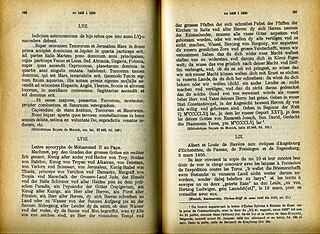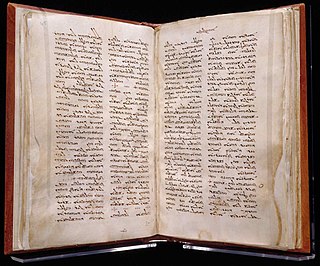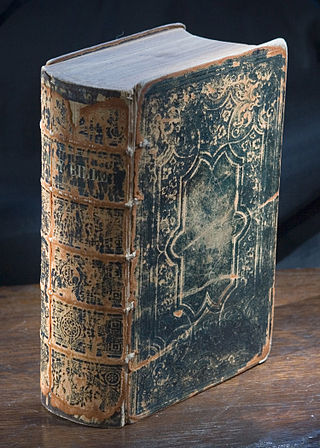
Apocrypha is biblical or related writings not forming part of the accepted canon of Scripture. While some might be of doubtful authorship or authenticity, in Christianity, the word apocryphal (ἀπόκρυφος) was first applied to writings which were to be read privately rather than in the public context of church services. Apocrypha were edifying Christian works that were not considered canonical Scripture. It was not until well after the Protestant Reformation that the word apocrypha was used by some ecclesiastics to mean "false," "spurious," "bad," or "heretical."

The Bible is a collection of religious texts or scriptures, some, all of which, or a variant of which, are held to be sacred in Christianity, Judaism, Samaritanism, Islam, Baha'i'ism and many other religions. The Bible is an anthology, a compilation of texts of a variety of forms, originally written in Hebrew, Aramaic, and Koine Greek. These texts include instructions, stories, poetry, and prophecies, and other genres. The collection of materials that are accepted as part of the Bible by a particular religious tradition or community is called a biblical canon. Believers in the Bible generally consider it to be a product of divine inspiration, but the way they understand what that means and interpret the text varies.

The Diatessaron is the most prominent early gospel harmony, and was created in the Syriac language by Tatian, an Assyrian early Christian apologist and ascetic. Tatian sought to combine all the textual material he found in the four gospels - Matthew, Mark, Luke, and John - into a single coherent narrative of Jesus's life and death. However, and in contradistinction to most later gospel harmonists, Tatian appears not to have been motivated by any aspiration to validate the four separate canonical gospel accounts; or to demonstrate that, as they stood, they could each be shown as being without inconsistency or error.
The New Testament (NT) is the second division of the Christian biblical canon. It discusses the teachings and person of Jesus, as well as events in first-century Christianity. The New Testament's background, the first division of the Christian Bible, is called the Old Testament, which is based primarily upon the Hebrew Bible; together they are regarded as sacred scripture by Christians.
Tatian of Adiabene, or Tatian the Syrian or Tatian the Assyrian, was an Assyrian Christian writer and theologian of the 2nd century.

Messianic Judaism is a modernist and syncretic movement of Protestant Christianity that incorporates some elements of Judaism and other Jewish traditions into evangelicalism.
Biblical studies is the academic application of a set of diverse disciplines to the study of the Bible. For its theory and methods, the field draws on disciplines ranging from ancient history, historical criticism, philology, theology, textual criticism, literary criticism, historical backgrounds, mythology, and comparative religion.

The Aramaic original New Testament theory is the belief that the Christian New Testament was originally written in Aramaic.
The rabbinical translations of Matthew are rabbinical versions of the Gospel of Matthew that are written in Hebrew; Shem Tob's Hebrew Gospel of Matthew, the Du Tillet Matthew, and the Münster Matthew, and which were used in polemical debate with Catholics.

Disputes regarding the internal consistency and textual integrity of the Bible have a long history.
In contrast to the variety of absolute or personal names of God in the Old Testament, the New Testament uses only two, according to the International Standard Bible Encyclopaedia. From the 20th century onwards, "a number of scholars find various evidence for the name [YHWH or related form] in the New Testament.
The Council of Jamnia was a council purportedly held late in the 1st century AD to finalize the development of the canon of the Hebrew Bible in response to Christianity. It has also been hypothesized to be the occasion when the Jewish authorities decided to exclude believers in Jesus as the Messiah from synagogue attendance, as referenced by interpretations of John 9:22 in the New Testament. The writing of the Birkat haMinim benediction is attributed to Shmuel ha-Katan at the supposed Council of Jamnia.
Bruce D. Chilton is an American scholar of early Christianity and Judaism, and an Episcopalian priest. He is Bernard Iddings Bell Professor of Religion at Bard College, formerly Lillian Claus Professor of New Testament at Yale University, and Rector of the Church of St John the Evangelist He holds a PhD in New Testament from Cambridge University. He has previously held academic positions at the Universities of Cambridge, Sheffield, and Münster.

A gospel harmony is an attempt to compile the canonical gospels of the Christian New Testament into a single account. This may take the form either of a single, merged narrative, or a tabular format with one column for each gospel, technically known as a synopsis, although the word harmony is often used for both.

Bible translations into Aramaic covers both Jewish translations into Aramaic (Targum) and Christian translations into Aramaic, also called Syriac (Peshitta).
Nicholas Perrin is an American academic administrator and religious scholar, currently serving as the 16th president of Trinity International University, a Christian university located in Deerfield, Illinois.
A biblical canon is a set of texts which a particular Jewish or Christian religious community regards as part of the Bible.
The canon of the New Testament is the set of books many modern Christians regard as divinely inspired and constituting the New Testament of the Christian Bible. For historical Christians, canonicalization was based on whether the material was from authors socially approximate to the apostles and not based solely on divine inspiration. Scholars from the 19th century onwards have disputed this. Many liberal scholars believe that the New Testament texts were not written by apostles, while many conservative continue to defend apostolic authorship. For most, the canon is an agreed-upon list of 27 books that includes the canonical Gospels, Acts, letters attributed to various apostles, and Revelation. Although there are many textual variations, most scholars believe that the original text of the New Testament can be known with a high level of probability. The books of the canon of the New Testament were written before 120 AD. Although the list of what books constituted the canon differed among the hundreds of churches in antiquity, according to ancient church historian Eusebius there was a consensus that the same 27 books constituting the canon today were the same 27 books generally recognized in the first century. For the Orthodox, the recognition of these writings as authoritative was formalized in the Second Council of Trullan of 692. The Catholic Church provided a conciliar definition of its biblical canon in 382 at the (local) Council of Rome as well as at the Council of Trent of 1545, reaffirming the Canons of Florence of 1442 and North African Councils of 393–419. For the Church of England, it was made dogmatic on the Thirty-Nine Articles of 1563; for Calvinism, on the Westminster Confession of Faith of 1647.
George Eulan Howard was an American Hebraist, noted for his publication of an old Hebrew edition of Matthew. He was a full Professor Emeritus and Head of the Department of Religion and Hebrew (Ret.) at the University of Georgia, Athens, GA. Howard also was a former President of the Society of Biblical Literature, Southeastern Region.

Shem Tob's Hebrew Gospel of Matthew is the oldest extant Hebrew version of the Gospel of Matthew. It was included in the 14th-century work Eben Boḥan by the Spanish Jewish Rabbi Shem-Tov ben Isaac ben Shaprut. George Howard has argued that Shem Tov's Matthew comes from a much earlier Hebrew text that was later translated into Greek and other languages. A characteristic feature of this Hebrew gospel is the appearance in 20 places of השם, in the abbreviated form ה״, where the Gospel of Matthew has Κύριος.








